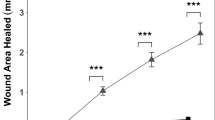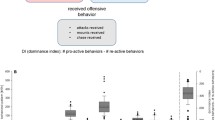Abstract
Immune system function is affected by a variety of exogenous and endogenous stressors. Most studies have focused on the effect of stressors on immune function, but not necessarily on trade-offs within the immune system and interactions with energy-mobilizing hormones. In this study, we examined how bactericidal ability and corticosterone interacted by applying acute restraint stress in a non-model organism, the side-blotched lizard (Uta stansburiana), 10 days after receiving a cutaneous wound. We found a decrease in bactericidal ability in wounded animals after restraint stress. However, the percentage healed during the first 7 days was positively correlated with bactericidal ability 10 days after wounding. In addition, the magnitude of change in corticosterone concentration during the acute stress was positively correlated with the percentage of wound healing during the first 3 days. These two relationships may demonstrate a “faster is better” strategy. If energy is invested heavily in the initial wound healing stages, the individual may be able to mount a more effective immune and stress response earlier.





Similar content being viewed by others
References
Angelier F, Wingfield JC (2013) Importance of the glucocorticoid stress response in a changing world: theory, hypotheses and perspectives. Gen Comp Endocrinol 190:118–128. doi:10.1016/j.ygcen.2013.05.022
Bonneaud C, Mazuc J, Gonzalez G, Haussy C, Chastel O, Faivre B, Sorci G (2003) Assessing the cost of mounting an immune response. Am Nat 161(3):367–379. doi:10.1086/346134
Breuner CW, Patterson SH, Hahn TP (2008) In search of relationships between the acute adrenocortical response and fitness. Gen Comp Endocrinol 157(3):288–295. doi:10.1016/j.ygcen.2008.05.017
Breuner CW, Delehanty B, Boonstra R (2013) Evaluating stress in natural populations of vertebrates: total CORT is not good enough. Funct Ecol 27(1):24–36. doi:10.1111/1365-2435.12016
Brooks KC, Mateo JM (2013) Chronically raised glucocorticoids reduce innate immune function in Belding’s ground squirrels (Urocitellus beldingi) after an immune challenge. Gen Comp Endocrinol 193:149–157. doi:10.1016/j.ygcen.2013.07.019
Christian LM, Graham JE, Padgett DA, Glaser R, Kiecolt-Glaser JK (2007) Stress and wound healing. NeuroImmunoModulation 13(5–6):337–346
Demas GE, Zysling DA, Beechler BR, Muehlenbein MP, French SS (2011) Beyond phytohaemagglutinin: assessing vertebrate immune function across ecological contexts. J Anim Ecol 80(4):710–730. doi:10.1111/j.1365-2656.2011.01813.x
Dhabhar FS (2009a) Enhancing versus suppressive effects of stress on immune function: implications for immunoprotection and immunopathology. NeuroImmunoModulation 16(5):300–317
Dhabhar FS (2009b) A hassle a day may keep the pathogens away: the fight-or-flight stress response and the augmentation of immune function. Integr Comp Biol 49(3):215–236. doi:10.1093/icb/icp045
Dhabhar FS, McEwen BS (1997) Acute stress enhances while chronic stress suppresses cell-mediated immunity in vivo: a potential role for leukocyte trafficking. Brain Behav Immun 11(4):286–306
Dhabhar FS, Miller AH, McEwen BS, Spencer RL (1995) Effects of stress on immune cell distribution—dynamics and hormonal mechanisms. J Immunol 154(10):5511–5527
Dhabhar FS, Malarkey WB, Neri E, McEwen BS (2012) Stress-induced redistribution of immune cells—from barracks to boulevards to battlefields: a tale of three hormones. Psychoneuroendocrinology 37(9):1345–1368
Dobbs CM, Feng N, Beck FM, Sheridan JF (1996) Neuroendocrine regulation of cytokine production during experimental influenza viral infection: effects of restraint stress-induced elevation in endogenous corticosterone. J Immunol 157(5):1870–1877
Ebrecht M, Hextall J, Kirtley L-G, Taylor A, Dyson M, Weinman J (2004) Perceived stress and cortisol levels predict speed of wound healing in healthy male adults. Psychoneuroendocrinology 29(6):798–809. doi:10.1016/S0306-4530(03)00144-6
French SS, Moore MC (2008) Immune function varies with reproductive stage and context in female and male tree lizards, Urosaurus ornatus. Gen Comp Endocrinol 155(1):148–156
French SS, Neuman-Lee LA (2012) Improved ex vivo method for microbiocidal activity across vertebrate species. Biol Open 1(5):482–487
French SS, Matt KS, Moore MC (2006) The effects of stress on wound healing in male tree lizards (Urosaurus ornatus). Gen Comp Endocrinol 145(2):128–132
French SS, DeNardo DF, Moore MC (2007a) Trade-offs between the reproductive and immune systems: facultative responses to resources or obligate responses to reproduction? Am Nat 170(1):79–89
French SS, McLemore R, Vernon B, Johnston GIH, Moore MC (2007b) Corticosterone modulation of reproductive and immune systems trade-offs in female tree lizards: long-term corticosterone manipulations via injectable gelling material. J Exp Biol 210(16):2859–2865
French S, Fokidis H, Moore M (2008) Variation in stress and innate immunity in the tree lizard (Urosaurus ornatus) across an urban–rural gradient. J Comp Physiol B: Biochem Syst Environ Physiol 178(8):997–1005
French SS, DeNardo DF, Greives TJ, Strand CR, Demas GE (2010) Human disturbance alters endocrine and immune responses in the Galapagos marine iguana (Amblyrhynchus cristatus). Horm Behav 58(5):792–799. doi:10.1016/j.yhbeh.2010.08.001
Hasselgren P-O (1999) Glucocorticoids and muscle catabolism. Curr Opin Clin Nutr Metab Care 2(3):201–205
Hawes AS, Richardson RP, Antonacci AC, Calvano SE (1995) Chronic pathophysiologic elevation of corticosterone after thermal injury or thermal injury and burn wound infection adversely affects body mass, lymphocyte numbers, and outcome. J Burn Care Res 16(1):1–15
Hopkins WA, DuRant SE (2011) Innate immunity and stress physiology of eastern hellbenders (Cryptobranchus alleganiensis) from two stream reaches with differing habitat quality. Gen Comp Endocrinol 174(2):107–115
Hübner G, Brauchle M, Smola H, Madlener M, Fässler R, Werner S (1996) Differential regulation of pro-inflammatory cytokines during wound healing in normal and glucocorticoid-treated mice. Cytokine 8(7):548–556. doi:10.1006/cyto.1996.0074
Janeway CJ, Travers P, Walport M, Shlomchik M (2001) Immunobiology: the immune system in health and disease, 5th edn. Garland Science, New York
Lochmiller RL, Deerenberg C (2000) Trade-offs in evolutionary immunology: just what is the cost of immunity? Oikos 88(1):87–98. doi:10.1034/j.1600-0706.2000.880110.x
Lucas LD, French SS (2012) Stress-induced tradeoffs in a free-living lizard across a variable landscape: consequences for individuals and populations. PLoS ONE 7(11):e49895
Maderson PFA, Roth SI (1972) A histological study of the early stages of cutaneous wound healing in lizards in in vivo and in vitro. J Exp Zool 180(2):175–185. doi:10.1002/jez.1401800205
Marra PP, Holberton RL (1998) Corticosterone levels as indicators of habitat quality: effects of habitat segregation in a migratory bird during the non-breeding season. Oecologia 116(1–2):284–292. doi:10.1007/s004420050590
Martin P (1997) Wound healing—aiming for perfect skin regeneration. Science 276(5309):75–81
Matson KD, Cohen AA, Klasing KC, Ricklefs RE, Scheuerlein A (2006) No simple answers for ecological immunology: relationships among immune indices at the individual level break down at the species level in waterfowl. Proc R Soc B: Biol Sci 273(1588):815–822
McEwen BS (2007) Physiology and neurobiology of stress and adaptation: central role of the brain. Physiol Rev 87(3):873–904. doi:10.1152/physrev.00041.2006
Moore MC (1986) Elevated testosterone levels during nonbreeding-season territoriality in a fall-breeding lizard, Sceloporus jarrovi. J Comp Physiol A: Neuroethol Sens Neural Behav Physiol 158(2):159–163
Moore IT, Jessop TS (2003) Stress, reproduction, and adrenocortical modulation in amphibians and reptiles. Horm Behav 43(1):39–47
Moore I, Greene M, Lerner D, Asher C, Krohmer R, Hess D, Whittier J, Mason R (2005) Physiological evidence for reproductive suppression in the introduced population of brown tree snakes (Boiga irregularis) on Guam. Biol Conserv 121(1):91–98
Padgett DA, Marucha PT, Sheridan JF (1998) Restraint stress slows cutaneous wound healing in mice. Brain Behav Immun 12(1):64–73. doi:10.1006/brbi.1997.0512
Parker WS, Pianka ER (1975) Comparative ecology of populations of the lizard Uta stansburiana. Copeia 1975(4):615–632
Rojas I-G, Padgett DA, Sheridan JF, Marucha PT (2002) Stress-induced susceptibility to bacterial infection during cutaneous wound healing. Brain Behav Immun 16(1):74–84. doi:10.1006/brbi.2000.0619
Romero LM (2004) Physiological stress in ecology: lessons from biomedical research. Trends Ecol Evol 19(5):249–255. doi:10.1016/j.tree.2004.03.008
Sapolsky RM, Romero LM, Munck AU (2000) How do glucocorticoids influence stress responses? Integrating permissive, suppressive, stimulatory, and preparative actions. Endocr Rev 21(1):55–89
Selye H (1946) The general adaptation syndrome and the diseases of adaptation. J Clin Endocrinol 6(2):117–230
Smith DA, Barker IK (1988) Healing of cutaneous wounds in the common garter snake (Thamnophis sirtalis). Can J Vet Res 52(1):111
Sorrells SF, Sapolsky RM (2007) An inflammatory review of glucocorticoid actions in the CNS. Brain Behav Immun 21(3):259–272. doi:10.1016/j.bbi.2006.11.006
Tinkle DW (1967) The life and demography of the side-blotched lizard, Uta stansburiana. Miscellaneous Publications, University of Michigan Museum of Zoology 132:1–182
Tucunduva M, Borelli P, Silva JRMC (2001) Experimental study of induced inflammation in the Brazilian Boa (Boa constrictor constrictor). J Comp Pathol 125(2–3):174–181. doi:10.1053/jcpa.2001.0500
Werner S, Grose R (2003) Regulation of wound healing by growth factors and cytokines. Physiol Rev 83(3):835–870
Wingfield JC (2005) The concept of allostasis: coping with a capricious environment. J Mammal 86(2):248–254
Wingfield JC, Romero LM (2011) Adrenocortical responses to stress and their modulation in free-living vertebrates. In: Comprehensive physiology. Handbook of physiology, the endocrine system, coping with the environment: neural and endocrine mechanism. American Physiological Society, pp 211–234
Zimmerman LM, Vogel LA, Bowden RM (2010) Understanding the vertebrate immune system: insights from the reptilian perspective. J Exp Biol 213(5):661–671. doi:10.1242/jeb.038315
Acknowledgments
We would like to thank L. D. Lucas for running the radioimmunoassays and A. R. Spence for analyzing the wound healing images. Additional thanks to G. D. Smith, G. R. Hopkins, A. M. Durso, E. D. Brodie, Jr., and four anonymous reviewers for providing critical comments to an earlier draft of this manuscript.
Author information
Authors and Affiliations
Corresponding author
Additional information
Communicated by G. Heldmaier.
Rights and permissions
About this article
Cite this article
Neuman-Lee, L.A., French, S.S. Wound healing reduces stress-induced immune changes: evidence for immune prioritization in the side-blotched lizard. J Comp Physiol B 184, 623–629 (2014). https://doi.org/10.1007/s00360-014-0826-z
Received:
Revised:
Accepted:
Published:
Issue Date:
DOI: https://doi.org/10.1007/s00360-014-0826-z




